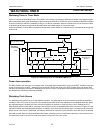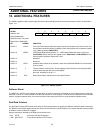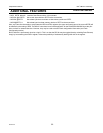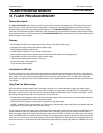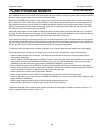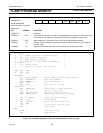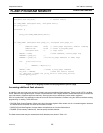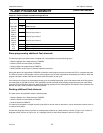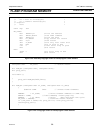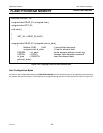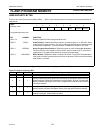
Philips Semiconductors
User’s Manual - Preliminary -
P89LPC901/902/903
FLASH PROGRAM MEMORY
2003 Dec 8 94
ing to FMDATA. However, each location in the page register can only be written once following each LOAD command. Attempts
to write to a page register location more than once should be avoided.
FMADRH and FMADRL[7:4] are used to select a page of code memory for the erase-program function. When the erase-pro-
gram command is written to FMCON, the locations within the code memory page that correspond to updated locations in the
page register will have their contents erased and programmed with the contents of their corresponding locations in the page
register. Only the bytes that were loaded into the page register will be erased and programmed in the user code array. Other
bytes within the user code memory will not be affected.
Writing the erase-program command (68H) to FMCON will start the erase-program process and place the CPU in a program-
idle state. The CPU will remain in this idle state until the erase-program cycle is either completed or terminated by an interrupt.
When the program-idle state is exited, FMCON will contain status information for the cycle.
If an interrupt occurs during an erase/programming cycle, the erase/programming cycle will be aborted and the OI flag (Opera-
tion Interrupted) in FMCON will be set. If the application permits interrupts during erasing-programming, the user code should
check the OI flag (FMCON.0) after each erase-programming operation to see if the operation was aborted. If the operation was
aborted, the user’s code will need to repeat the process starting with loading the page register.
The erase-program cycle takes 4ms to complete, regardless of the number of bytes that were loaded into the page register.
Erasing-programming of a single byte (or multiple bytes) in code memory is accomplished using the following steps:
• Write the LOAD command (00H) to FMCON. The LOAD command will clear all locations in the page register and their
corresponding update flags.
• Write the address within the page register to FMADRL. Since the loading the page register uses FMADRL[5:0], and since the
erase-program command uses FMADRH and FMADRL[7:4], the user can write the byte location within the page register
(FMADRL[3:0]) and the code memory page address (FMADRH and FMADRL[7:4]) at this time.
• Write the data to be programmed to FMDATA. This will increment FMADRL pointing to the next byte in the page register.
• Write the address of the next byte to be programmed to FMADRL, if desired. (Not needed for contiguous bytes since FMADRL
is auto-incremented). All bytes to be programmed must be within the same page.
• Write the data for the next byte to be programmed to FMDATA.
• Repeat writing of FMADRL and/or FMDATA until all desired bytes have been loaded into the page register.
• Write the page address in user code memory to FMADRH and FMADRL[7:4], if not previously included when writing the page
register address to FMADRL[3:0].
• Write the erase-program command (68H) to FMCON,starting the erase-program cycle.
• Read FMCON to check status. If aborted, repeat starting with the LOAD command.
An assembly language routine to load the page register and perform an erase/program operation is shown in Figure 14-2. A
similar C-language routine is shown in Figure 14-3.




